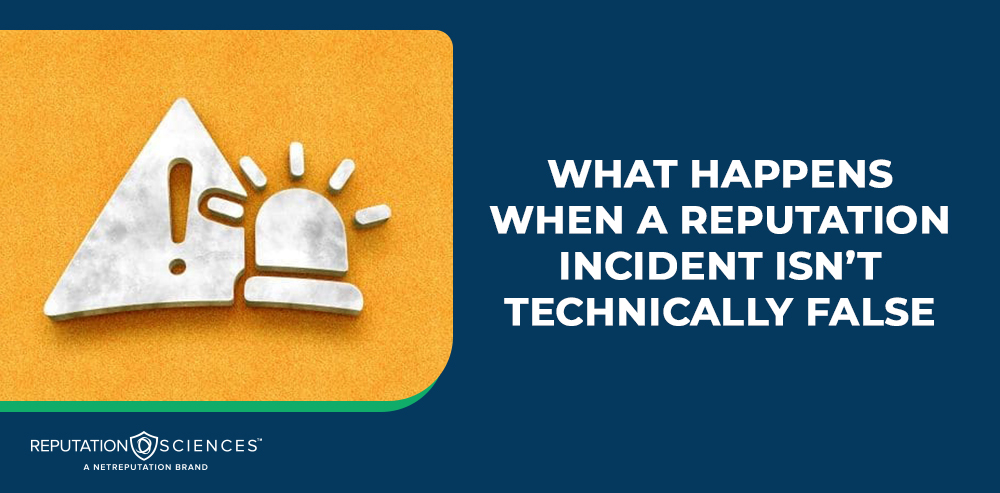What Happens When a Reputation Incident Isn’t Technically False

Not all reputation incidents are based on lies. Sometimes the damage comes from something that’s true—or partly true. And that can be harder to fix. When negative information about a company, leader, or brand is accurate, it still impacts public perception, consumer trust, and investor confidence. This kind of reputational damage doesn’t fall under defamation, but the harm is real and can have significant financial implications.
Understanding the distinction between a false accusation and a negative truth is crucial to any effective reputation management strategy. And knowing how to respond can determine how quickly you recover—or whether you recover at all. A reputation incident, whether true or false, poses potential risks that can quickly erode trust and damage an organization’s reputation.
What Is a Reputation Incident?
A reputation incident is any event that negatively impacts how people perceive a person, company, or brand. It could be a news report, social media post, online review, or public statement. These incidents often trigger a business reputation crisis or damage a brand’s image in ways that affect customer trust, market value, and long-term success.
They don’t always involve lies. Some incidents are based on truth—like a real data breach, actual unethical conduct, or poor product quality. However, even when the facts are accurate, the consequences can be severe and lead to negative publicity that spreads rapidly among the general public and other stakeholders.
When the Incident Is True
If the incident is true, it isn’t legally defamation. But it can still lead to serious consequences, including:
- Lost revenue from customers walking away due to poor quality or unethical practices
- Drop in stock value and market capitalization due to shaken investor confidence
- Negative media coverage that amplifies the damage and attracts scrutiny from regulators
- Regulatory fines if laws or industry standards were broken
- Erosion of consumer trust and the organization’s reputation
Take Wells Fargo or Volkswagen, for example. The incidents that damaged their reputations were based on facts, including the use of fake accounts and emissions manipulation in diesel vehicles. These weren’t false accusations—they were real actions with real consequences that serve as cautionary tales for other companies.
Why True Incidents Still Hurt
When the public learns about unethical practices or poor behavior, even if it’s true, trust is quickly eroded. Customers question the company’s values and may leave, while employees lose morale and productivity. Partners and other stakeholders pull back, making future collaborations and business growth harder. The company’s image suffers, and the brand’s equity declines significantly.
The problem spreads rapidly. Online reviews, media reports, and social media posts can exponentially amplify the impact. A single story can damage a company’s reputation overnight, leading to financial losses and long-term challenges in rebuilding a positive reputation.
How Reputational Damage Affects Business
A damaged reputation impacts more than just perception; it affects the entire business ecosystem:
- Market capitalization may fall sharply, reflecting lost investor confidence
- Top talent might choose not to apply or stay, impacting workforce quality
- Existing customers may leave for competitors, leading to lost revenue
- New partnerships become harder to secure, limiting growth opportunities
- Relevant stakeholders demand action or transparent communication to restore confidence
In short, a business’s future can be significantly affected by a single reputation incident—even when it isn’t false.
What Business Leaders Can Do
Business leaders play a crucial role in managing reputational risk and mitigating damage. Key steps include:
- Own the facts. Don’t deny what’s true. Clearly and promptly acknowledge the problem to demonstrate accountability.
- Take swift action. Respond fast with corrective steps. A quick response signals commitment and prevents rumors from spreading.
- Communicate transparently. Share what went wrong and what you’re doing to fix it with the general public and other stakeholders.
- Engage key stakeholders. This includes customers, employees, investors, regulators, and partners, all working together to rebuild trust collectively.
- Commit to change. Implement new policies, enhance internal controls, and hold leadership accountable to prevent future incidents.
These steps don’t erase the incident, but they show a commitment to accountability and transparency. That’s key to rebuilding trust and restoring a positive brand reputation.
Preventing Future Incidents
A strong reputation management plan doesn’t just react to problems—it prevents them. Companies need to:
- Monitor social media and online reviews regularly to catch early signs of negative reviews or potential risks
- Act on customer feedback before it escalates into larger reputation damage
- Establish internal controls and ethical guidelines to avoid unethical practices and poor quality products
- Build a business continuity plan that includes reputation crises to ensure quick and coordinated responses
- Regularly review risk management practices to adapt to emerging threats and vulnerabilities
These proactive measures help protect the organization’s reputation and reduce the likelihood of future reputation incidents turning into full crises.
When to Call for Outside Help
Some incidents require legal support or third-party reviews to manage reputational damage effectively. An independent investigation can demonstrate to stakeholders that the company is committed to change and transparency. In major cases, legal action may be necessary to clarify facts, limit liability, or correct misinformation spreading in the media or on social media.
Final Takeaway
Even when a reputation incident is based on truth, it can still have a profoundly damaging effect on the business. The stakes are high: lost revenue, reduced brand value, and long-term trust issues with customers and other stakeholders.
Owning up to the mistake, acting quickly with a prompt response, and being transparent are the best ways to limit damage. Rebuilding takes time, but with the right steps, companies can fully recover, protect against future incidents, and restore a positive reputation.
Every reputation incident—true or not—is a chance to lead better. And the way a company responds says more than the incident itself, shaping the brand reputation and customer trust for years to come.
